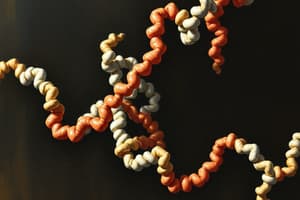Podcast
Questions and Answers
What type of bonding is responsible for the formation of secondary structures in a polypeptide?
What type of bonding is responsible for the formation of secondary structures in a polypeptide?
- Hydrogen bonding between the peptide backbone atoms (correct)
- Van der Waals interactions between the alpha-helices
- Covalent bonding between the R groups
- Ionic bonding between side chains
In which type of structure do the R groups (side chains) point away from the helix?
In which type of structure do the R groups (side chains) point away from the helix?
- Tertiary structure
- Quaternary structure
- Beta-pleated sheets
- Alpha-helix (correct)
What type of structure is formed by the assembly of multiple polypeptides?
What type of structure is formed by the assembly of multiple polypeptides?
- Alpha-helix
- Secondary structure
- Tertiary structure
- Quaternary structure (correct)
What experimental technique is considered the gold standard for determining the 3D structure of proteins?
What experimental technique is considered the gold standard for determining the 3D structure of proteins?
What does the Ramachandran plot show for amino acids in a protein?
What does the Ramachandran plot show for amino acids in a protein?
Which type of structure is held together by different chemical interactions between side chains or between a side chain and the peptide backbone atoms?
Which type of structure is held together by different chemical interactions between side chains or between a side chain and the peptide backbone atoms?
What is the diameter order from smallest to largest for beta-turns, 310 helix, and pi-helix?
What is the diameter order from smallest to largest for beta-turns, 310 helix, and pi-helix?
Which type of protein is formed by 2 or more identical subunits or polypeptide chains?
Which type of protein is formed by 2 or more identical subunits or polypeptide chains?
What holds together the tertiary structure of a protein?
What holds together the tertiary structure of a protein?
What is the formula for calculating dilution factor (DF)?
What is the formula for calculating dilution factor (DF)?
At what pH does the Coomassie Brilliant Blue G-250 dye have a blue color?
At what pH does the Coomassie Brilliant Blue G-250 dye have a blue color?
What stabilizes the anionic, blue form of the Coomassie Brilliant Blue G-250 dye?
What stabilizes the anionic, blue form of the Coomassie Brilliant Blue G-250 dye?
What is the wavelength of maximum absorption of the Coomassie Brilliant Blue G-250 dye when it is not yet bound to a protein?
What is the wavelength of maximum absorption of the Coomassie Brilliant Blue G-250 dye when it is not yet bound to a protein?
What is used to prepare the Bradford reagent?
What is used to prepare the Bradford reagent?
How is the dilution factor (DF) calculated in the context of protein samples in the Bradford assay?
How is the dilution factor (DF) calculated in the context of protein samples in the Bradford assay?
What is the concentration of the dilute solution if the concentration of the stock solution is 300 ug/uL and the dilution factor is 150?
What is the concentration of the dilute solution if the concentration of the stock solution is 300 ug/uL and the dilution factor is 150?
What is the traditional one-step preparation solute volume for a 400 uL solution at a dilution factor of 4000?
What is the traditional one-step preparation solute volume for a 400 uL solution at a dilution factor of 4000?
In step dilution, what are two smaller dilution factors used to achieve a target larger dilution factor of 40?
In step dilution, what are two smaller dilution factors used to achieve a target larger dilution factor of 40?
What is the overall dilution factor (DF) with respect to stock solution when preparing a 400 uL solution at a 1:4000 dilution using step dilution with an intermediate solution?
What is the overall dilution factor (DF) with respect to stock solution when preparing a 400 uL solution at a 1:4000 dilution using step dilution with an intermediate solution?
What does the binding of dye to protein allow according to the text?
What does the binding of dye to protein allow according to the text?
Which combination will result in a green color for Coomassie Brilliant Blue G-250?
Which combination will result in a green color for Coomassie Brilliant Blue G-250?
Flashcards are hidden until you start studying




